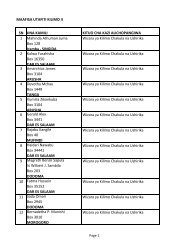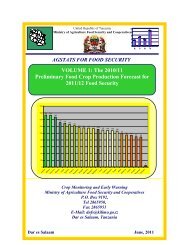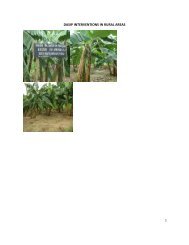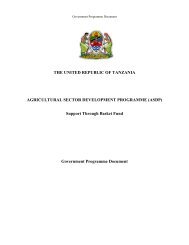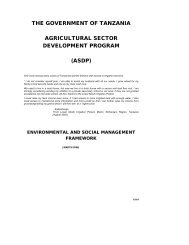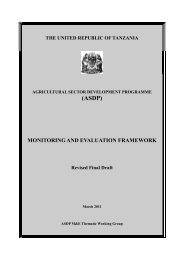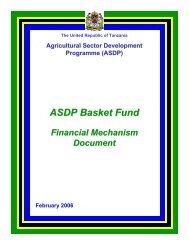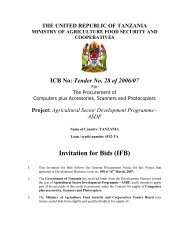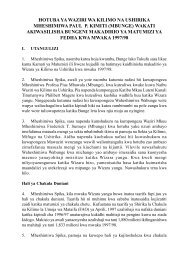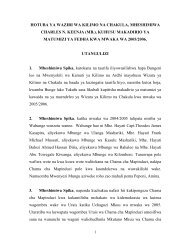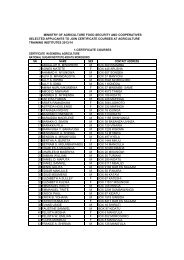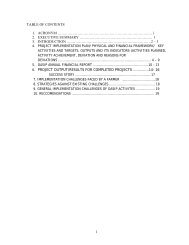Large Scale Farm Report - Ministry Of Agriculture, Food and ...
Large Scale Farm Report - Ministry Of Agriculture, Food and ...
Large Scale Farm Report - Ministry Of Agriculture, Food and ...
You also want an ePaper? Increase the reach of your titles
YUMPU automatically turns print PDFs into web optimized ePapers that Google loves.
REGIONAL PROFILES80Access to infrastructure <strong>and</strong> services is moderate to high. Access to <strong>and</strong> receipt of extension services was one of the lowestin the country.Kagera is one of the regions having the lowest number of farm employees. It has the 14 th highest number of permanentemployees <strong>and</strong> 2 nd lowest number of temporary employees.4.16 ShinyangaShinyanga has 30 large scale farms <strong>and</strong> it has the sixth lowest area of l<strong>and</strong> under cultivation (1,489 ha) <strong>and</strong> has low l<strong>and</strong>utilisation per farm (an average of 119 hectares per farm). Virtually no permanent crops are grown in the region. Cerealsare the most important crops in the region. The region has the eighth largest planted area of maize, seventh largest forpaddy <strong>and</strong> second largest for sorghum, however it had one of the lowest yields for maize during the census year. Duringthe Census year planting was largely during the long rainy season.The region is not important for cassava, beans <strong>and</strong> fruit <strong>and</strong> vegetable production but, it has the sixth largest planted area ofgroundnuts in Tanzania. In terms of cash crops, Shinyanga is among the most important regions for cotton production inlarge scale farms.Shinyanga has one of the smallest areas of irrigation <strong>and</strong> lowest percent of erosion control facilities in Tanzania.Considering Shinyanga is one of the important crop growing regions, it only has low contact with extension services.However, the region has the highest number planted trees on large scale farms.Kagera has the sixth smallest number of farm implements in the country. It has the eleventh smallest number of tractors,fourth smallest number of harrows <strong>and</strong> has the sixth largest number of ploughs. The region has no harvesters.Shinyanga is one of the regions having the smallest population of livestock on large scale farms. It has a low number ofcattle (eighth lowest <strong>and</strong> mostly indigenous); <strong>and</strong> has low number of goats <strong>and</strong> sheep. The region has no pigs reared onlarge scale farms. It has low milk production <strong>and</strong> has one of the lowest farm gate prices for milk.Shinyanga is one of the regions having the lowest chicken population on large scale farms; about sixty percent areimproved chicken, mostly layers. A small number of eggs are produced.The rate of disease infection is moderate to low but high for the fowl typhoid II. In general the access to livestockinfrastructure <strong>and</strong> services is moderate. The main extension provider is the Government.Shinyanga is one of the regions having the lowest number of farm employees. It has the lowest number of permanentemployees <strong>and</strong> 8 th lowest number of temporary employees.4.17 SingidaSingida has 27 large scale farms with a l<strong>and</strong> area totaling 1,193 hectares under large scale farm crop production <strong>and</strong> theregion is characterized by having virtually no permanent crops. The l<strong>and</strong> area utilized per crop growing large scale farm is128 ha <strong>and</strong> a high percent of the l<strong>and</strong> area available is utilized. The region only has a long rainy season. In terms ofplanted area, the region is moderately important for cereals <strong>and</strong> whilst maize has a higher planted area than other cereals inthe region, it is an important region for the production of sorghum. The production of wheat is also relatively important.Tanzania <strong>Agriculture</strong> Sample Census – 2003



